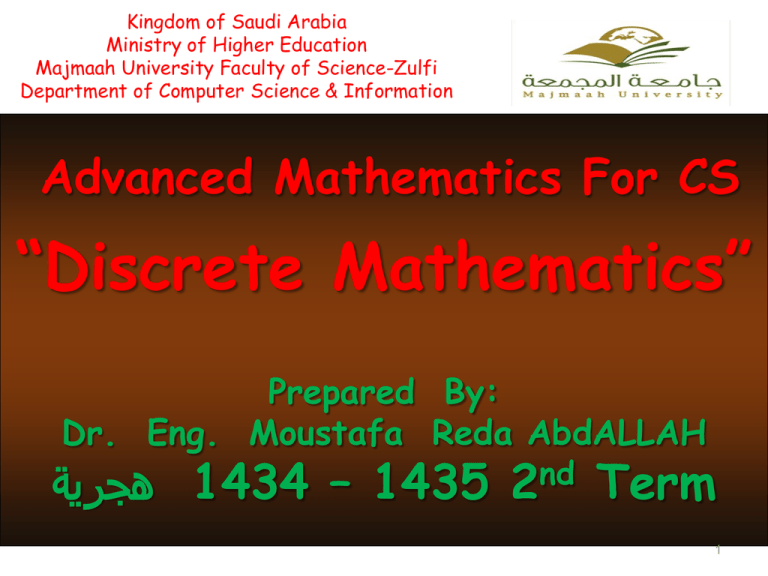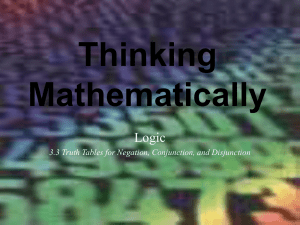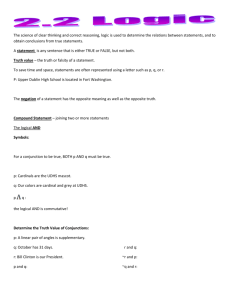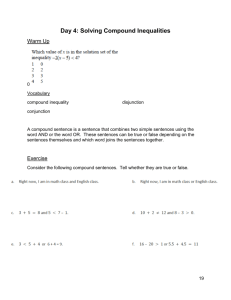
Kingdom of Saudi Arabia
Ministry of Higher Education
Majmaah University Faculty of Science-Zulfi
Department of Computer Science & Information
Advanced Mathematics For CS
“Discrete Mathematics”
Prepared By:
Dr. Eng. Moustafa Reda AbdALLAH
هجرية1434 – 1435 2nd Term
1
Course goals
• Mathematical Reasoning
المنطق الرياضي
– Logic, inference/deduction/conclusion حدس, proof
• Combinatorial analysis
طرق العد/تحليل عددي
– Count and enumerate objects
• Discrete structures
هياكل منفصلة
– Sets, sequences, functions, graphs, trees, relations
2
Main Topics
1.
2.
3.
4.
5.
6.
Logic
Proofs
Set Theory
Functions
Sequences
Graph Theory.
3
Textbook
• Discrete Mathematics and Its Applications ; Kenneth
H. Rosen, 7th edition, McGraw Hill, 2012.
4
Recommended Books
• A Beginner’s Guide to Discrete Mathematics; W. D. Wallis;
Birkhäuser; 2003.
• Discrete Mathematics; Richard Johnsonbaugh; 7th edition;
Prentice Hall International, 2009.
• Thinking Mathematically; Robert Blitzer; 4th edition; Pearson
Prentice Hall; 2010.
• Mathematical Ideas; Charles D. Miller, Vern E. Heern, John
Hornsby; Expanded 10th edition; Pearson Addison Wesley; 2004.
5
Prerequisites
• Basic knowledge of calculus .
• Basic knowledge in computer science.
6
Grading توزيع الدرجات
•
•
•
•
1st Midterm (6th/7th Week):
2nd Midterm (12th/13th Week):
Activities:
Final Exam:
• N.B.
10 Points.
10 Points.
20 Points.
60 Points.
Activities:
- Class Attendance,
- Assignments & Homework,
- Quizzes & Net Researches.
- Class Participation, Presentations (weekly).
7
Class Policy
• Never use smart phones in class.
• All the lectures and notes will be available for the
students.
• Weekly homework assigned on 1st part of the lecture
and due (must be achieved )يجب أن ينجزbefore the 2nd
part of the same weekly lecture.
• Must be your own work.
• Homework returned in class or by e-mail.
8
Lecture
One
9
1.0 Logic
Concepts
The
logic
mimic/imitate/copy
our
intuitions/feelings/insights by setting down (explaining)
constructs/concepts/ideas/theories/hypotheses
that
behave analogously مناظرة/بصورة متشابهة.
The logic furnishes statements that describe the
surrounding world that can be true/false. That the
world is made up of objects and that objects can be
organized to form collections of statements.
Used in numerous applications: circuit design, programs,
verification of correctness of programs, artificial
intelligence, etc.
10
1.1 Proposition
افتراض/ اقتراح
• Is a declarative statement خبرية/ جملة تصريحيةthat is either
true or false, but not both. It is not an Opinion, a
Command, or a Question. Such as:
–
–
–
–
Washington, D.C., is the capital of USA
California is adjacent to New York
1+1=2
2+2=5
• Not declarative
– What time is it? Question
– Read this carefully Command
– It is a nice day Opinion
11
1.2 Propositional Logic
التصريحي/المنطق الخبري
• Elementary/Simple statement is atomic, with a verb, subject and
object but no connectives (NOT, OR, AND, If…Then, Iff)
• Construct correct mathematical arguments الحجج.
• Give precise meaning to mathematical statements
• Focuses on the relationships among statements.
• Rules are used to distinguish between valid (True) and invalid
(False) arguments/statement. Hence logic assures us for any
combination/connection of these statements as being True/False.
12
1.3 False, True, Statements
Axiom مسلمة: False is the opposite to Truth.
A statement is a description of something, which
Is Not an Opinion, a Command, or Question. A
statement Is A Sentence عبارةThat Is Either True Or
False, but not both simultaneously.
Examples of statements:
– I’m 58 years old.
– I have 888 children.
– I always tell the truth.
– I’m lying to you.
Q’s: Which statements are:
True? False? Both? Neither?
13
1.3 False, True, Statements
True: I’m 58 years old.
False: I have 888 children.
I always tell the truth.
Both: IMPOSSIBLE, by our Axiom.
14
1.3 False, True, Statements
Neither:
I’m lying to you. (If viewed on its own )من تلقاء نفسها
Suppose that S = “I’m lying to you.” were true. In particular, I am
actually lying, so S is false. So it’s both true and false, impossible by
the Axiom.
فأنني:) أنني أكذب عليكS و من ثم عندما أخبرك (في الجملة. أنا أكذب في كالمي: صادقةS الجملة
ً أي أنني فع.أكذب في كذبي عليك
. كاذبةS ال ال أكذب عليك أي أن الجملة
Okay, so I guess S must be false. But then I must not be lying to
you. So the statement is true. Again it’s both true and false.
) أنني أكذب عليك فأننيS و من ثم عندما أخبرك (في الجملة. أنا ال أكذب في كالمي: كاذبةS الجملة
ً فع
. صادقةS ال أكذب عليك أي أن الجملة
In both cases we get the opposite of our assumption, so S is neither
true nor false.
15
Exercise Sets
1.1 - 1.3
I. In Exercises 1- 14, determine whether or not each sentence is a
Statement.
1. George W. Bush was the Democratic candidate for president in 2004.
2. John Kerry was the Republican candidate for president in2004.
3. Take the most interesting classes you can find.
4. Don't try to study on a Friday night in the dorms.
5. The average human brain contains 100 billion neurons.
6. There are 2.500.000 rivets in the Eiffel Tower.
7. Is the unexamined life worth living?
8. Is this the best of all possible worlds?
9. Some Catholic countries have legalized same-sex marriage.
l0. Some U.S. presidents were assassinated.
11. 9 + 6 = 16
12 . 9 x 6 = 64
16
Exercise Sets
1.1 - 1.3
II. Decide whether each of the following is a statement or is not a
statement.
1.
2.
3.
4.
5.
6.
7.
8.
9.
17
1.4 Symbolic Logic
ترميز المنطق/ المنطق الرمزي
• In symbolic logic, we use lower case
letters such as p, q, r, and s to represent
statements. Here are two examples:
• p: Riyadh is the capital of KSA.
• q: Abin Al-Haythim is one of the greatest muslim
scientists.
• Hence:
• The letter p represents the 1st statement.
• The letter q represents the 2nd statement.
18
1.5 Logical Operators/Connectives
الروابط المنطقية/العوامل
• If you're wealthy or well educated, then you'll be happy.
• We can break this statement down into three basic sentences:
You're wealthy, You're well educated, You'll be happy. These
sentences are called simple statements because each one
conveys/takes/sends/carries/transfers/delivers one idea with
no connecting words. Statements formed by combining two or
more simple statements are called compound statements. Logical
connectives are used to join simple statements to form a
compound statement. These Connectives include the words AND,
OR, IF . . . THEN, and IF AND ONLY IF.
• Compound statements appear throughout written and spoken
language. We need to be able to understand the logic of such
statements to analyze information objectively. Starting from
1.10, we will concentrate our analysis on four kinds of compound
statements.
19
1.5 Logical Operators/Connectives
الروابط المنطقية/العوامل
• Are used to form
simple ones.
لتكوين
compound propositions
تصريحات مركبة
from
•
Negation ( NOT, , )
– Unary : Operates on one Statement. p
•
Conjunction (االقترانAND, )
– Binary : Operates on two Statement. p q
•
Disjunction االنفصال/ Inclusive شاملOR (OR , v )
Binary : Operates on two Statement. p v q
•
Conditional/Implication إستلزام/تورط/تضمين/مشاركة/( شرطIf…Then … , … …)
Binary : Operates on two Statement. p q
•
Biconditional-statement/Equivellence …( التكـافؤIf And Only If… , … …)
Binary : Operates on two Statement. p q
20
1.5
Table of Logical Operators/Connectives
الروابط المنطقية/العوامل
Operation
Operator’s
Symbol
Usage
Name
Java Form
Negation
NOT
!
AND
&&
OR
||
If, Then
p ? q : r
If p Then q Else r
Iff
(p && q)||(!p && !q)
النفي
Conjunction
اإلقتران/الوصل
Disjunction
الفصل
Conditional
الشرط
Biconditional
ثنائية الشرط
21
1.6 Truth Tables
• Are the tables that indicate truth
/falsity of a given proposition either in
simple or complicated forms.
• True
• False
T,1
F,0
22
1.7 Negation
NOT p /
p / p
It is a Unary Operator (takes/affects One Argument)
23
1.7 Negation
• “Today is Friday”
p
– It is not the case that today is Friday
– Today is not Friday
p
p
• At least 10 inches of rain fell today in Miami
– It is not the case that at least 10 inches of rain fell
today in Miami
– Less than 10 inches of rain fell today in Miami
24
Exercise Sets
1.5, 1.6, 1.7
I. Give a negation and the resulting truth value of each of the
following inequalities (x = 1, 11 & y = 4, -5 & q = 2, 5 & r = 20, 17)
1. x 12 .
II.
2. y -6 .
3. q 5 .
4. r 19
5. 8 11
For each of the following statements:
p: Listening to classical music makes infants smarter.
q: Subliminal advertising makes you buy things.
r: Sigmund Freud's father was not 20 years older than his mother.
s: Humans and bananas do not share approximately 60% of the same DNA
structure.
Find: 1. p
2. q
3. r
4. s
III. Explain why the negation “r 4” is not “r 4”.
25
1.8
AND Statement “Conjunction”
االقتران- الوصل
If p and q represent two simple statements then the compound
statement "p and q“ is symbolized by p q (P AND q, p conjoined with q).
The compound statement formed by connecting statements with the
word and is called a conjunction.
The conjunction is :
i.
Idempotent: p p is equivalent to p .
ii.
Binary Operator ( مؤثر ثنائيtakes two
propositions.
iii. Commutative تبادلي: p q is the same as
qp.
iv.
Associative ترابطي: p (q r) , is the
as (p q) r, is the same as r (q p).
26
Conjunction: p q is true when both p and q are true. False otherwise
1.8
AND Statement “Conjunction”
االقتران- الوصل
• p: “Today is Friday”, q: “It is raining today”.
• p q : “Today is Friday AND / BUT لكن/ YET مع ذلك/
NEVERTHLESS بالرغم من ذلكit is raining today”
– True: on rainy Fridays.
– False: otherwise:
• Any day that is not a Friday
• Fridays when it does not rain
27
1.8
AND Statement “Conjunction”
االقتران- الوصل
Let p and q represent the following simple
statements:
p: It is after 5 P.M.
q: They are working.
Write each compound statement below in
symbolic form:
a. It is after 5 P.M. but they are working.
b. It is not after 5 P.M. yet they are not working.
SO LUTION
a. p q.
b. p q.
28
1.8
AND Statement “Conjunction”
الوصل – االقتران
Variety of ways to express the conjunction that appear in
compound statement
Symbolic
Statement
English
Statement
P: It is after 5 P.M.
q: They a e working
pq
p AND q.
pq
p BUT q.
pq
p YET q.
pq
p NEVERTHELESS q.
It is after 5 P.M. and
they are working.
It is after 5 P.M. but
they are working.
It is after 5 P.M. yet
they are working.
It is after 5 P.M.
nevertheless they are
29
working.
Exercise Set 1.8
Exercises 1-6, let p and q represent the following
simple statements: p: I'm leaving & q: You're
slaying. Write each of the following compound
statements in symbolic form.
1. I'm leaving and you're staying.
2. You’re staying and I'm leaving.
3. You’re staying and I'm not leaving.
4. I'm leaving and you're not staying.
5. You’re not staying, but I'm leaving.
6. I'm not leaving, but you‘re staying.
30
1.9 OR Statement “Disjunction”
االنفصال/ الفسخ/ الفصل
If p and q represent two simple statements then the compound
statement "p or q“ is symbolized by p q (P OR q, p disjoined with q).
The compound statement formed by connecting statements with the
word and is called a disjunction.
The disjunction is :
i.
Idempotent: p p is equivalent to p .
ii.
Binary Operator ( مؤثر ثنائيtakes two
propositions.
iii. Commutative تبادلي: p q is the same as
qp.
iv.
N.B.
Associative ترابطي: p (q r) , is the
as (p q) r, is the same as r (q p).
1. Disjunction: p v q is false when both p and q are false. True otherwise.
2. p True is always True.
3. p False is always p. 31
1.9 OR Statement “Disjunction”
الفصل
The connective or can mean two different things. For example, consider
this statement: I visited London or Paris. The statement can mean:
i.
I visited London or Paris, but not both.
This is an example of the EXCLUSIVE OR, which means "one or the
other, but not both."
ii.
By contrast, the statement can mean I visited London or Paris
or both. This is an example of the INCLUSIVE OR, which means "either
or both."
In our study and in mathematics in general, when the connective OR
appears, it means the inclusive OR. If p and q represent two simple
statements, then the compound statement "p OR q" means p OR q or
both. The compound statement formed by connecting statements with
the word OR is called a disjunction. The symbol for or is . Thus, we can
symbolize the compound statement "p or q or both" by p q.
32
1.9 OR Statement “Disjunction”
الفصل
• p q: “Today is Friday or it is raining today”
True:
–
•
•
•
Today is Friday
It is raining today
It is a rainy Friday
False
–
•
Today is not Friday and it does not rain
33
Exercise Set 1.9
In Exercises
1-4, write each symbolic
statement in words. Let p and q represent
the following simple statements:
p: I study.
q: I pass the course.
1. I study or I pass the course.
2. I pass the course or I do not study.
3. I study or I do not pass the course.
4. I do not study or I do not pass the course.
34
1.10 Relations Between “Negation”,
“Conjunction” and “Disjunction”
De Morgan’s Laws
• (p q) = p
q
• (p q) = p
q
35
Exercise Sets 1.5 1.10
I. In Exercises 1-12, write the negation of
each statement.
1. I'm going to Seattle or San Francisco.
2. This course covers logic or statistics.
3. I study or I do not pass.
4. I give up tobacco or I am not healthy.
5. I am not going and he is going'
6. I do not apply myself and I succeed'
7. A bill becomes law and it does not receive majority approval.
8. They see the show and they do not have tickets.
9. p q
10. p q
11. p (q r)
12.
p (q r)
36
Exercise Sets
1.5 1.10
II.
1.
2.
3.
4.
5.
6.
37
Exercise Sets
1.5 1.10
III. Answer the following:
IV. Let p, q, and r represent true, false, and false statements
respectively. Find the truth value of the given compound
statement:
1.
4.
7.
2.
5.
8.
3.
6.
38
Exercise Sets
1.5 1.10
V. Give the number of rows in the truth table of the following
statements.
1.
4.
2.
5.
3.
6.
VI.
VII.
39
Exercise Sets
1.5 1.10
VIII. Construct the truth table for:
1.
2.
5.
7.
6.
8.
3.
4.
9.
10.
IX. True or False:
1.
2.
3.
4.
X. In Exercises 1-10, write each symbolic statement in words. Let p and q
represent the following simple statements:
p: The father loves his son.
q: The son loves his father.
1. (p q)
4. q p
7. q p
8. p q
2. (q p)
5. (q p)
9. p q
3. p q
6. (p q)
10. q p
40
Exercise Sets
1.5 1.10
XI. Use one of De Morgan's Laws to write the
negation of each of the following statements.
1.
2.
3.
4.
5.
6.
41





